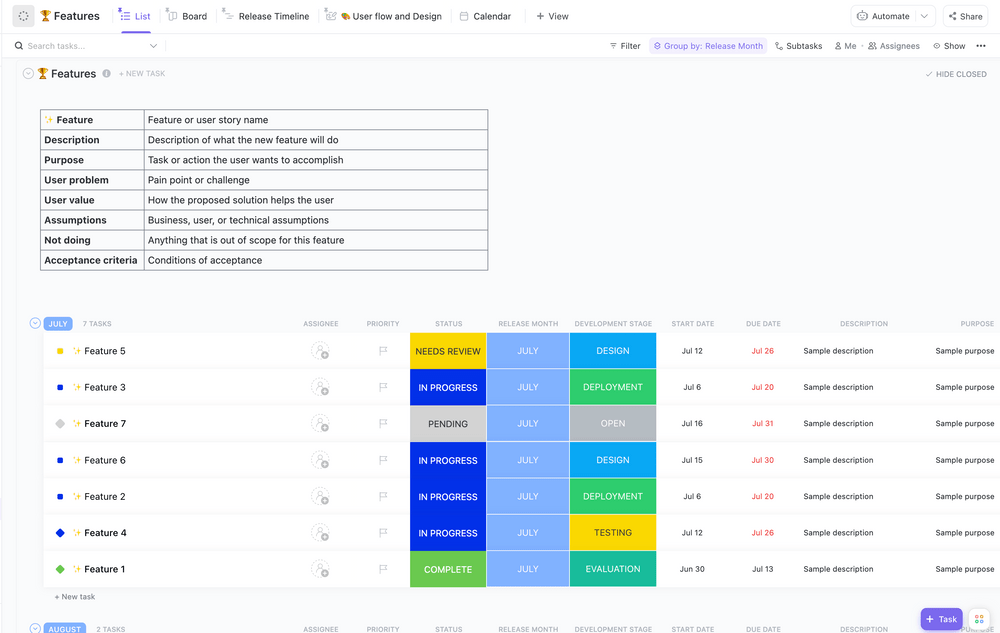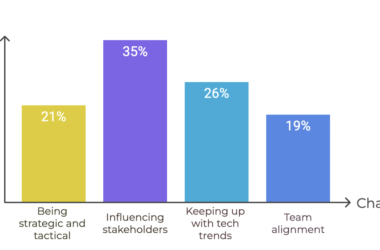Product management requires a 360-degree approach at work. As a product manager, you have to be involved in multiple threads, including product strategy, project workflow, product market fit, research and team collaboration to name a few.
To ensure a cohesive work environment among these cross-functional teams, you have to be able to switch between various roles super fast, be it leader, manager, strategist, innovator, or mentor. Even then, you may occasionally get stumped by a unique challenge in the workflow.
In this article, we will discuss the top 10 product management challenges and their solutions, along with helpful tools to manage your workload.
10 Product Management Challenges and Solutions
A day in the life of a product manager involves different kinds of tasks, such as:
- Studying product usage and user responses
- Planning new features
- Creating a vision board for the product’s future
- Monitoring market patterns and competitor activities
- Coordinating with technical, sales, and marketing teams
In a bid to accomplish so much, you may face many challenges, including:
1. Aligning teams and organizational communication
One of the common challenges in product management is aligning team communication and removing silos between departments. Siloed communication harms the overall health of the product as it may lead to unclear expectations, missed deadlines, and delays in deliverables.
You need to be completely in sync with the design and tech teams so the product timeline isn’t compromised. This means centralizing communication so that any new directive from the design team reaches the QA team in real time, for instance.
Solution
- Establish clear goals: Set specific, measurable objectives for each team. This helps everyone understand what they’re working toward and how their work fits into the bigger picture. This way, they know to keep the entire team involved in any changes in workflow
- Regular check-ins: Schedule consistent meetings where teams can update each other on progress, share insights, and discuss challenges. This keeps communication open and frequent
- Use collaboration tools: Implement tools like ClickUp, Slack, Trello, or Asana to centralize and streamline communication. These platforms allow for real-time updates and easy sharing of documents and feedback
2. Hitting deadlines
While managing a product, you must adhere to both internal and external deadlines. For example, the engineering team has due dates for deliverables and product launch deadlines. If these are not planned well, they can create a lot of stress within the workforce, which can harm the output quality.
If you keep missing deadlines, it might be time to revisit your work strategy and find solutions to ensure your project stays on track.
Solution
- Set attainable timelines: The key is to set timelines that you can comfortably achieve instead of having unrealistic goals. Keep in mind the quality and availability of resources and plan deadlines, keeping all involved teams in mind
- Break up the workflow: If the product roadmap looks too extensive, break it up into smaller tasks with smaller deadlines. Assign individual tasks to team members and follow through on their progress to determine the deadline for the next product stage
- Plan and analyze everything: You must plan resources before starting a project. It is a good idea to analyze previous projects and identify their pitfalls to make a better management plan for your current project flow
- Leverage management tools: Product management tools can be saviors in this scenario. An efficient tool can help with designing, planning, scheduling, and executing a project, along with centralizing communication and shared project calendars
ClickUp is one such tool that helps you centralize all project management tasks under one roof, so that you can view and track tasks, docs, and people involved in a product team. You can use ClickUp’s Project Management capabilities to help manage the entire lifecycle of your products, starting with product launches and ensure maximum productivity and quicker deliveries.
3. Balancing responsibilities
A product manager needs to deal with different tasks, stakeholders, and teams on a daily basis. This creates a struggle with priorities and balancing responsibilities.
The tech team might reach out with an urgent request at the same time as the documentation team. The product marketing software may be malfunctioning, or you may need to prioritize collecting customer feedback to make a critical decision. As a product manager, you are expected to handle each task with ease and balance them to finish on time.
Solution
- Distinguish between urgent and important: A project manager needs to keep their head clear about which tasks are essential for the product’s success and which tasks need urgent attention. While trying to deal with urgent tasks, you should not overlook or compromise on the important ones
- Take user feedback into account: If you cannot decide which feature to add to a product or which issue to troubleshoot first, consult user feedback for help. Identify their pain points and focus your update activities on those tasks before all
- Identify business-critical tasks: The goal is to identify tasks in the product workflow that impact the overall product and its performance. Check which tasks are aligned with your key goals and prioritize them under all circumstances
Use product management templates to determine and track crucial tasks. ClickUp’s Product Roadmap Template provides a macro-level view of your entire product development process, highlighting goals and commitments for better focus.
Product managers can use this template to track and share the product roadmap, provide regular updates to stakeholders, and publish release notes. This can help the team identify and accomplish business-critical tasks on time and plan each step of the product development cycle without getting derailed by last-minute issues.
4. Keeping up with technology
The technology market is ever-changing, and product managers need to be aware of trends and advancements to integrate into their product design. Often, it is difficult to keep up with such a dynamic landscape, with so little time to learn and adapt.
Solution
- Engage with your tech staff: Your product team likely has insights and knowledge about tech news and trends. Encourage them to share ideas, resources, and articles on emerging technology and also involve them in product design meetings
- Conduct research: Keep yourself updated with tech news through videos, blogs, podcasts, tutorials, social media posts, and so on. Open yourself up to new ideas and research relevant technologies that can enhance your product and attract your user base
5. Nurturing creativity within product teams
In a fast-paced product team, there is often no time to nurture creativity and innovation. A process is in place, and everyone must follow it for timely results.
However, a lack of creative culture can lead to setbacks in the long run, so a product manager must foster an atmosphere of uniqueness and innovation.
Solution
- Encourage idea-sharing: Invite your team to share their ideas and collaborate by creating channels for discussing new initiatives. When people feel inspired to think out of the box, they can come up with innovative solutions
- Don’t be too strict with the process: Deadlines are important, but it is also crucial to nurture the spirit of creativity without pressure. Encourage your team to share ideas without worrying about the logistics so that you can tap into unique approaches
6. Product research and strategizing
Product research is different from market/technology research. It entails the vision you have for your product in the future, be it six months or six years. To sustain the success of your product, you must make it futureproof. And that can be done with solid research and strategizing.
But you may struggle to determine their product’s future customer value and how to expand it to continue meeting the needs of their target audience.
Solution
- Determine your product’s purpose: The first thing to do is determine the purpose of your product. To do so, interview your customers, note their requirements and pain points, and identify the product’s bugs that deter its success. Then, apply these insights to strategize the product’s future based on what purpose it can fulfill now and five years down the line
- Build a brand: Products come and go, but brands live for a long time. If you are unsure about the growth of a product, it’s better to launch it under the brand umbrella so you can adapt its specs or features in the future without alienating your customers
- Set clear research objectives: Your product research should be focused on clear objectives, such as user requirements, pricing, competitiveness, and so on. Perform market analysis, customer surveys, product landscape study, etc., to understand how your product may shape up in the coming months or years and build a futureproof product strategy
Pro Tip: Use the ClickUp Product Requirements template to record product information and future requirements in an organized manner. This allows you to exchange ideas and strategies, collaborate effectively, and document all your decisions in a centralized manner, making it easier to revisit prior decisions and build on release plans.
7. Data management
One of the common product management challenges is product analytics and data management. Product teams have large datasets about usage, clicks, website tracking, scrolling, action tracking, screen recordings, etc.
With such a high volume of data, product managers often struggle to identify patterns and extract actionable customer insights. Additionally, you need to record and manage internal data, such as resource timing, task statuses, documents, and so on.
Solution
- Organize the collected data: Implement a system for collecting data and organize the results through product management tools. ClickUp Dashboards help you sort and represent data in an organized way, with important product indicators and visual widgets for time tracking, team member activities, knowledge resources, and so on. You can also gain AI insights through the dashboard data with ClickUp Brain insights

- Set actionable metrics: It is the product manager’s responsibility to set and track metrics that matter the most to your product. It is easier to manage large data volumes when you know what to save and what to look for. Organizing and analyzing these metrics helps to find improvement areas and base future developments on them. It also helps the entire team make the right use of their data without having to sift through the entire set every time they need insights
8. Managing privacy concerns
Data privacy is a big concern when companies collect a lot of data on their user base. There are data management and privacy laws like GDPR that you must follow, as well as keep faith with your customers that their data will not be used in any untoward ways.
As a product manager, you must be aware of these privacy issues and have a plan to tackle them.
Solution
- Tell users what data you’re collecting: Your users have the right to know what personal information you want to collect about them and why. Be transparent about your data practices, as many countries have laws against non-consensual data aggregation
- Evaluate your data needs: You may realize that you’re collecting more data than you need. Evaluate what data you actually need and collect minimum information to safeguard your product legally. For instance, you need data about how users use your product, not where they live and where they work. So, collect what you need and don’t store extra information
- Implement data privacy measures in the product: Make sure you add privacy notices and terms and conditions in your product prominently. Add security measures like two-factor authentication if applicable. And most importantly, ensure your internal processes are also built around the ethical treatment of user data
9. Training and employee retention strategies
Product management heavily relies on the product manager, developers, design team, QA people, and many more employees. It is important to keep the product team happy, motivated, and productive.
This includes providing onboarding and training new members and engaging the existing team to boost employee satisfaction. Employees’ lack of skills and morale can reflect poorly on the product.
Solution
- Make good hires: As the product manager, you must make informed hiring decisions to bring in the best fit for your team. Don’t focus solely on one interview or one degree. Include your current team in the hiring process to ensure the new hire can imbibe the team culture easily
- Create training modules with clear objectives: Your training material should be goal-based and oriented to the product. Offer relevant training to employees based on their job roles and skill levels. Encourage them to upskill and explore additional avenues that can benefit their job role
- Be a good listener: Employees often struggle to share concerns with the product manager. Create a welcoming environment for your team to share their issues and find solutions. This helps boost employee satisfaction and retention rates
- Conduct regular surveys: Send your employees regular surveys to gather feedback about their work experience, workloads, and relationships with colleagues. This feedback can help you keep employees happy, identify and remove bottlenecks from your product team, and maximize productivity
10. Improving customer satisfaction
Your product is nothing if it doesn’t meet the customer needs. One of the product managers’ primary responsibilities is to ensure that the product provides what the customers need. Sometimes, it is difficult to get that insight from unstructured data or fluctuating performances.
Solution
- Set up customer feedback channels in your product: Make it easy for users to provide feedback by integrating ratings and feedback channels into your website. Use product feedback software to build an easy communication channel between you and your users. This helps you understand user experience better, as they are likely to give you feedback in real-time while they’re using the product
- Use quantitative and qualitative tools: Quantifying customer experience with star ratings and customer satisfaction scores is an easy way to spot trends and changes in customer responses. Similarly, seeking qualitative feedback by asking customers to describe their issues and suggest ways to improve the product can help tons. It also makes customers feel valued and heard, which is another big advantage
Most product management issues stem from a lack of planning, organization, and analysis of the product, the product team members, and users. To avoid them, you need a way to centralize all product tasks and establish control over the workflow.
ClickUp Product Management Software helps you do just that with cross-functional teamwork, tools, and knowledge. With this all-in-one product tool, you can simplify the product lifecycle, improve collaboration, and boost customer satisfaction.
You can collaborate on roadmaps, manage sprint backlogs, solve bugs, automate workflows, collect product feedback and track real-time progress with agile dashboards. To say the least, it has everything to make the life of a product manager easier.

Tools for Dealing with Product Management Challenges
Product managers juggle a fast-paced and varied work environment with multiple avenues, such as research, development, execution, analysis, and product feedback. You need a solid project management framework and product-specific workflow templates to manage this agile workflow.
The ClickUp Product Platform is the best product management solution to map your vision, align team activities, and sprint to market. You can:
- Create documents and connect them to product workflows using ClickUp Docs
- Create trackable goals connected to your work using ClickUp Goals
- Integrate DevOps and workflow automation
- Track issues and manage sprints
- Integrate AI capabilities with ClickUp Brain
- Address customer feedback
- Report in real-time through dashboards

In addition to these features, you can utilize ClickUp’s predefined product templates to organize your workflow and share updates.
ClickUp’s Product Brief Document is a ready-to-use customizable document that ensures cross-functional alignment between teams. It includes example outlines for goals, success metrics, release management plans, functional specs, and more.
Get the Right Product Management Tool!
While product management challenges are common, they should be viewed as learning opportunities to improve your operational workflow or your product.
As we discussed earlier, it’s all about distinguishing between urgent and important requests and prioritizing issues that have the most impact on your product and your business. Easier said than done? Not really.
By employing the right product management platform, you can gain insights to improve collaboration, manage product development, meet deadlines, and even exceed expectations. ClickUp can be your one-stop solution to all these product management challenges and more.
Sign up for free on ClickUp and revolutionize your product management workflow!
The post How to Tackle Product Management Challenges for Maximum Productivity appeared first on ClickUp.








